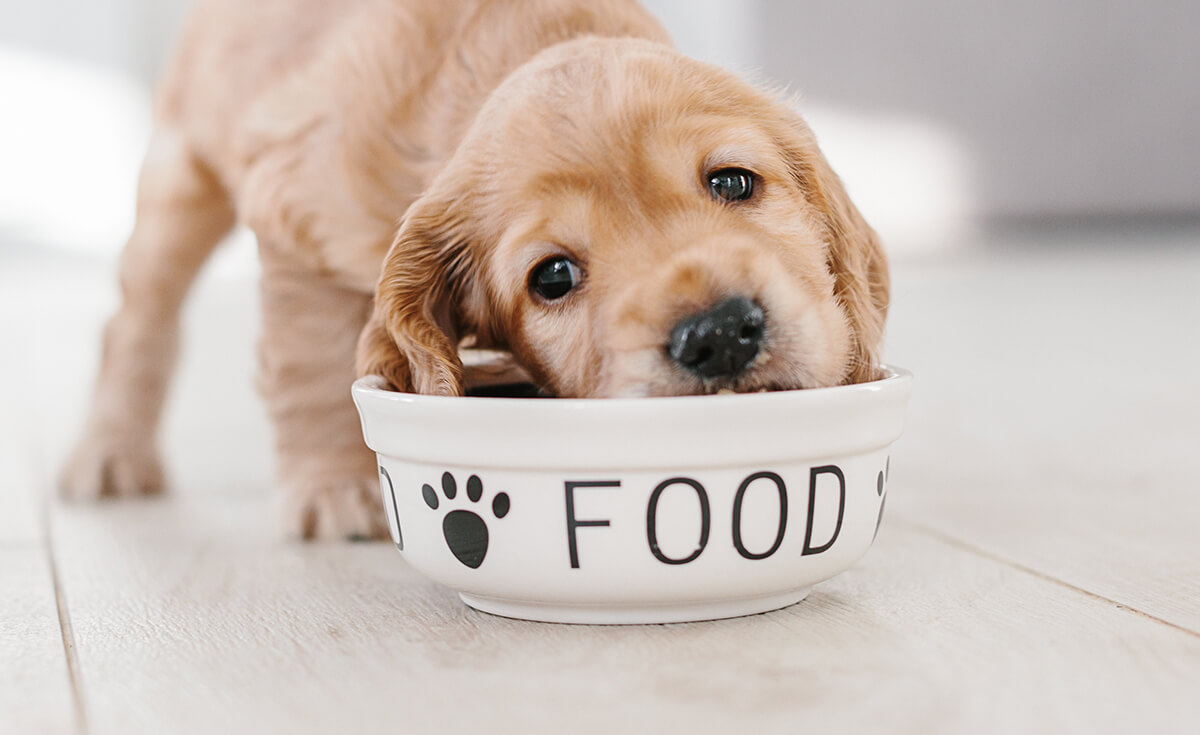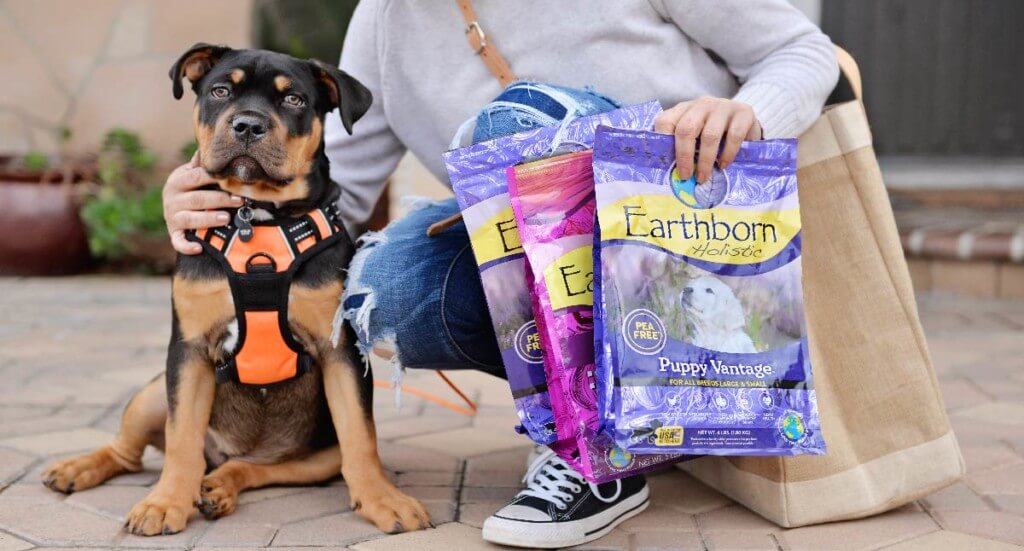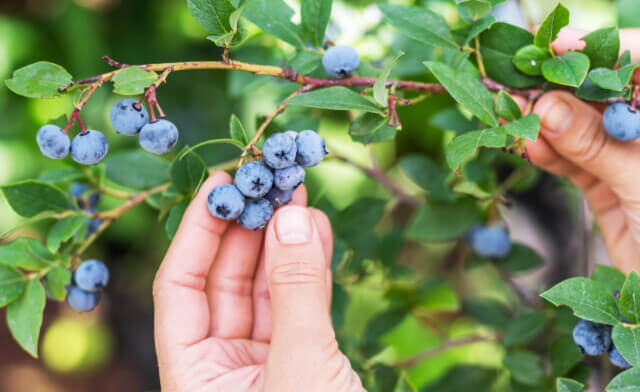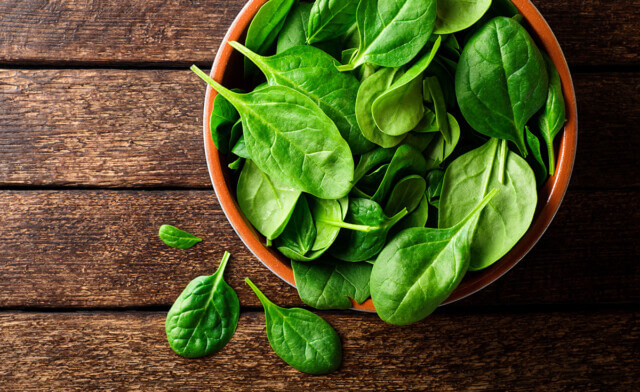Top Tips for Planning Out Food for Puppies
Bringing a new puppy into your home is an exciting time filled with lots of cuddles, playtime, and new responsibilities. And one of the most important aspects of puppy care is ensuring they receive the right nutrition to support their rapid growth and development.
In this guide, we’ll share our top tips and insights into planning out a diet for your puppy – from scheduling meals to understanding the nutritional content of their food. Ready to become a puppy meal-planning pro? Then let’s get started!

Schedule Meals
Establishing a regular feeding schedule is an essential part of puppy care. Puppies have smaller stomachs than adult dogs and burn off energy quickly, so they need to eat several small meals throughout the day. A consistent feeding schedule helps regulate your puppy’s digestion and ensures they’re getting all the nutrients they need.
How much to feed a puppy a day depends on their age, size, and breed. Smaller breeds typically require more calories per pound of body weight than larger breeds due to their faster metabolism. Your vet can provide guidance on the appropriate amount of food based on your puppy’s specific needs.
A feeding puppy schedule also helps with house training. Puppies typically need to go to the bathroom 15-30 minutes after eating. By feeding your puppy at the same times each day, you can predict when they’ll need to go outside. This is a great way to help speed up the house training process.
A consistent feeding schedule can also help prevent behavioral issues related to food. Puppies that are fed at random times may become anxious and start begging for food throughout the day. By sticking to a schedule, you can help your puppy understand when it’s time to eat and when it’s not. It’s also important to remember that the puppy food diet should be balanced and nutritious, and the puppy pet food you choose should be appropriate for their age and size.
Find Good Puppy Kibble
Dry kibble is a popular choice for many pup parents due to its convenience and long shelf life. When choosing a dry kibble for puppies, it’s important to look for one that’s specifically formulated for puppies. Puppy kibble is typically higher in protein and enriched with essential vitamins and minerals to support your puppy’s growth and development.
The best kibble for large breed puppies will have a balanced ratio of calcium and phosphorus to support bone development and prevent growth-related health issues. It’s also important to look for a high protein puppy food for large breeds as protein supports muscle development and provides energy.
When determining how much kibble to feed your puppy, make sure to follow the feeding guidelines on the packaging. These guidelines are usually based on your puppy’s age and weight. However, these are just guidelines and the actual amount your puppy needs may vary depending on their activity level and metabolism.
When choosing a top puppy dry food, it’s vital to consider the quality of the ingredients. Look for a kibble that lists a source of animal protein as the first ingredient and doesn’t contain any artificial colors, flavors, or preservatives. The highest quality kibble will also be free from fillers and by-products, ensuring your puppy gets the most nutritional benefit from their food.
When it comes to finding the best kibble for your puppy, Earthborn Holistic’s Puppy Vantage recipe stands out. This dry dog food recipe is complete and balanced, providing all the nutrients necessary for your puppy’s growth and development.
It’s formulated to meet the nutritional levels established by the AAFCO Dog Food Nutrient Profiles for growth, gestation, and lactation, including growth of large size dogs. This means that an average puppy can eat Puppy Vantage as a healthy diet without the need for additional supplements. Plus, it contains docosahexaenoic acid (DHA), an omega-3 fatty acid found in fish oils that supports healthy brain development.

Find Good Wet Puppy Food
Wet food can be a great addition to your puppy’s diet. It’s typically more palatable than dry food and can be easier for young puppies to eat. When choosing a wet food for your pup, look for one that’s specifically formulated for puppies. Like kibble, puppy wet food is typically higher in protein and enriched with essential nutrients.
The best wet food for puppies will contain high-quality ingredients, including a source of animal protein as the first ingredient. As with dry food, it’s also important to look for a food that doesn’t contain any artificial colors, flavors, or preservatives. Wet food can be particularly beneficial for puppies that are teething or have dental issues, as it’s softer and easier to chew.
If you’re considering wet food for your puppy, it’s important to look for a range of options that are high in protein and enriched with essential nutrients. Earthborn Holistic does not offer any wet food recipes for puppies at this time, but their adult wet food recipes like K95 are complete and balanced, meaning they contain all the necessary nutrients your pup will need when they reach adulthood. Wet food can also make a great topper for a nutritious kibble, like our Coastal Catch recipe. This recipe is made with herring meal as the main ingredient and is developed for all life stages. It’s also small enough for tiny mouths to enjoy, making it a great choice for small breed puppies.
If you have a small breed puppy, you may want to look for the best wet food for small breed puppies. Small breed puppies have smaller mouths and may find it easier to eat wet food. Additionally, small breed puppies have a faster metabolism and may benefit from the higher moisture content in wet food, which can help keep them hydrated.
On the other hand, if you have a large breed puppy, you may want to consider wet food for large breed puppies. Large breed puppies have a slower growth rate and specific nutritional needs, and there are wet foods specially formulated to meet these needs.
Feeding your puppy a combination of wet and dry food can also be a good option. This can provide the benefits of both types of food and can make mealtimes more interesting for your puppy. However, it’s important to ensure that the combined amount of food you’re feeding is appropriate for your puppy’s age, size, and activity level. Always remember the importance of feeding puppies wet food in moderation and stick to the recommended portion sizes on the packaging.
Be Aware of Nutrition
Nutrition plays a crucial role in your puppy’s growth and development. Puppies require a diet high in protein to support their rapid growth, as well as a balanced ratio of calcium and phosphorus for bone development. They also need a range of vitamins and minerals to support their overall health.
When choosing the best nutritional puppy food, look for one that’s nutritionally complete and balanced. This means that the food contains all the nutrients your puppy needs in the right proportions. You can usually find this information on the food’s packaging.
A puppy nutrition chart can be a helpful tool in understanding your puppy’s nutritional needs. These charts provide information on the recommended levels of various nutrients for puppies at different stages of growth. However, these charts should be used as a guide only, and the actual amount of food your puppy needs may vary depending on their individual needs.
It’s also a good idea to consult with your vet or a pet nutrition expert. They can provide personalized advice based on your puppy’s age, size, breed, and health status. They can also help you understand the information on pet food labels and choose a food that meets your puppy’s nutritional needs. Remember, a healthy puppy diet is one that is balanced and complete, providing all the necessary nutrients for your puppy’s growth and development.
Try Grain-Free
Grain-free diets have become popular in recent years, and there are many grain-free foods available for puppies. These diets can be a good option for puppies with food allergies or sensitivities, as grains are a common allergen.
When choosing a grain-free puppy food, you’ll want to ensure that it’s nutritionally complete and balanced. Some grain-free foods can be low in certain nutrients, so it’s important to choose a food that’s fortified with these nutrients.
If you have a small breed puppy, you may want to look for the best grain-free puppy food for small breeds. Small breed puppies have a faster metabolism and may benefit from the higher protein content typically found in grain-free foods.
By comparison, if you have a large breed puppy, you may want to consider grain-free puppy food for large breeds. Large breed puppies have specific nutritional needs, and there are grain-free foods specially formulated to meet these needs.
Before making any major changes to your puppy’s diet, it’s always a good idea to consult with your veterinarian. They can provide guidance based on your puppy’s specific needs and help you choose the best grain-free puppy food.
Keep Track of Their Weight
Monitoring your puppy’s weight is an important part of their care. Puppies grow rapidly, and their weight can provide a good indication of their overall health. Regular weight checks can help you ensure your puppy is growing at a healthy rate and not becoming overweight or underweight.
When it comes to feeding your puppy, the amount of food they need will depend on their weight. A feeding chart for puppies by weight can be a helpful tool in determining how much to feed your puppy. These charts provide feeding guidelines based on your puppy’s weight, but remember, these are just guidelines and the actual amount your puppy needs may vary depending on their age, breed, and activity level.
If you have a larger breed like a Labrador, you might be wondering how much to feed a lab puppy by weight. Larger breeds typically require fewer calories per pound of body weight than smaller breeds, but they also grow for a longer period of time. Your vet can provide personalized feeding advice based on your puppy’s breed and expected adult size.
Regular weight checks and consultations with your vet can help you adjust your puppy’s diet as needed to ensure they’re getting the right amount of food. If your puppy is underweight, there are foods available that can help them gain weight. The best dog food for puppies to gain weight will be high in calories and protein to support healthy growth.
Try Three Meals a Day
Feeding your puppy three meals a day can help ensure they’re getting the nutrition they need. Puppies have small stomachs and high energy needs, so they benefit from eating several small meals throughout the day rather than one or two large meals.
How much food to feed a puppy per day depends on their age, size, and activity level. Younger puppies typically require more calories per pound of body weight than older puppies and adult dogs. A puppy feeding guide by weight can be a helpful tool in determining how much to feed your puppy.
As your puppy grows and their activity level changes, their feeding needs will change as well. Regular consultations with your vet can help you adjust your puppy’s diet as needed to ensure they’re getting the right amount of food.
While it’s important to ensure your puppy is getting enough food, it’s also important not to overfeed them. Overfeeding can lead to rapid weight gain, which can increase your puppy’s risk of developing health issues later in life. Always keep track of how much food should puppies eat per day to maintain a healthy weight.
Switch to Dog Food Slowly
As your puppy grows, they’ll eventually need to switch from puppy food to adult dog food. This transition should be done slowly to avoid upsetting your puppy’s stomach.
When to switch puppy to dry food or adult food depends on your puppy’s age, size, and breed. Small breed puppies typically reach adulthood earlier than large breed puppies.
Small breeds, which weigh under 25 pounds when fully grown, reach adult size at 10-12 months of age and may be ready to switch to adult food at 9-10 months of age.
On the other hand, large breed puppies grow more slowly and may not be ready to switch to adult food until they’re 12 to 24 months old. Large- and giant-breed dogs that weigh more than 50 pounds when fully grown might not be ready to switch to an adult food until they’re 12 to 24 months old.
The transition from puppy food to adult food should be done gradually over a period of a week or two. Start by replacing a small amount of your puppy’s current food with the new food, and gradually increase the amount of new food over time. This slow transition can help prevent digestive upset and make the change easier for your puppy to accept.
Every puppy is unique and there’s no one-size-fits-all answer to when can you switch a puppy to dog food. Always consult with your vet to determine the best time to make the switch based on your puppy’s individual needs. Understanding the difference between puppy and adult food can help you make the best decision for your pet’s nutritional needs.
Ensuring Your Puppy’s Nutritional Success
Planning out food for your puppy involves a lot of considerations, from choosing the right type of food to establishing a feeding schedule. Remember, every puppy is unique and what works for one might not work for another. Always consult with your vet or a pet nutrition expert to ensure your puppy is getting the nutrition they need.
With the right approach, you can help your puppy grow into a healthy and happy adult dog. Feeding your puppy is not just about providing them with food. It’s about creating a routine, understanding their nutritional needs, and making adjustments as they grow. With these tips, you’ll be well on your way to providing your puppy with the best possible start in life!




